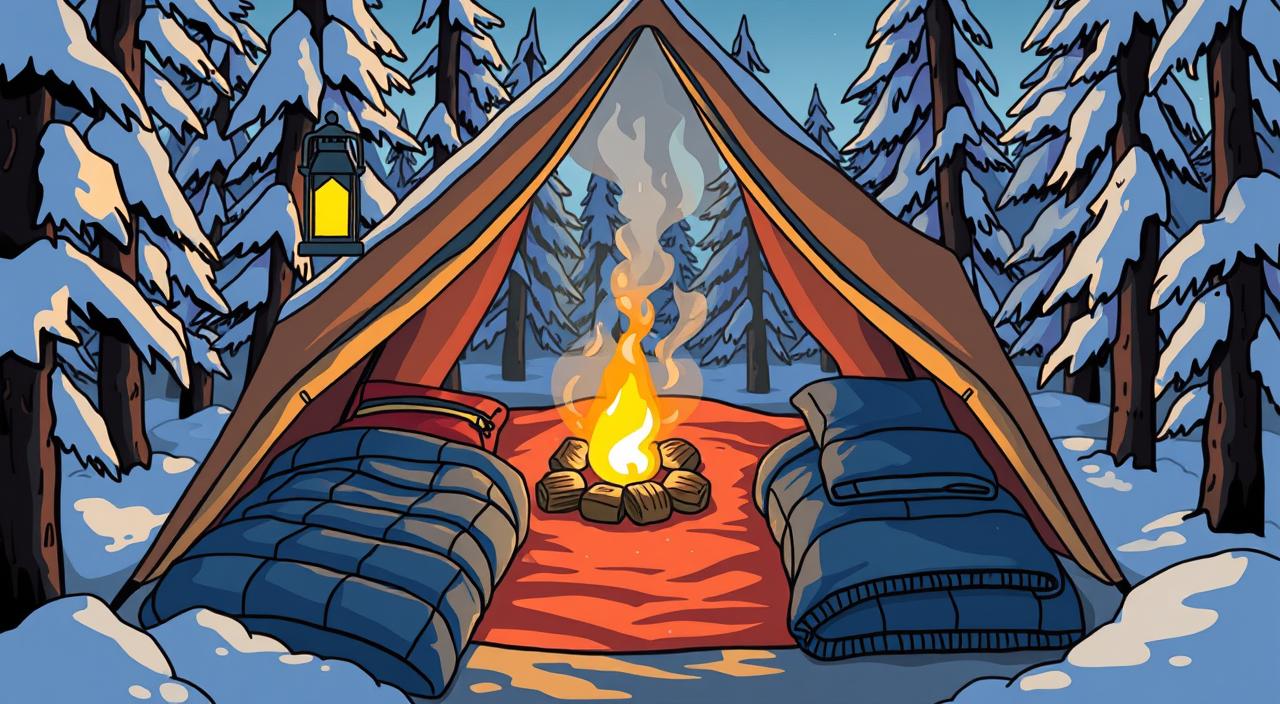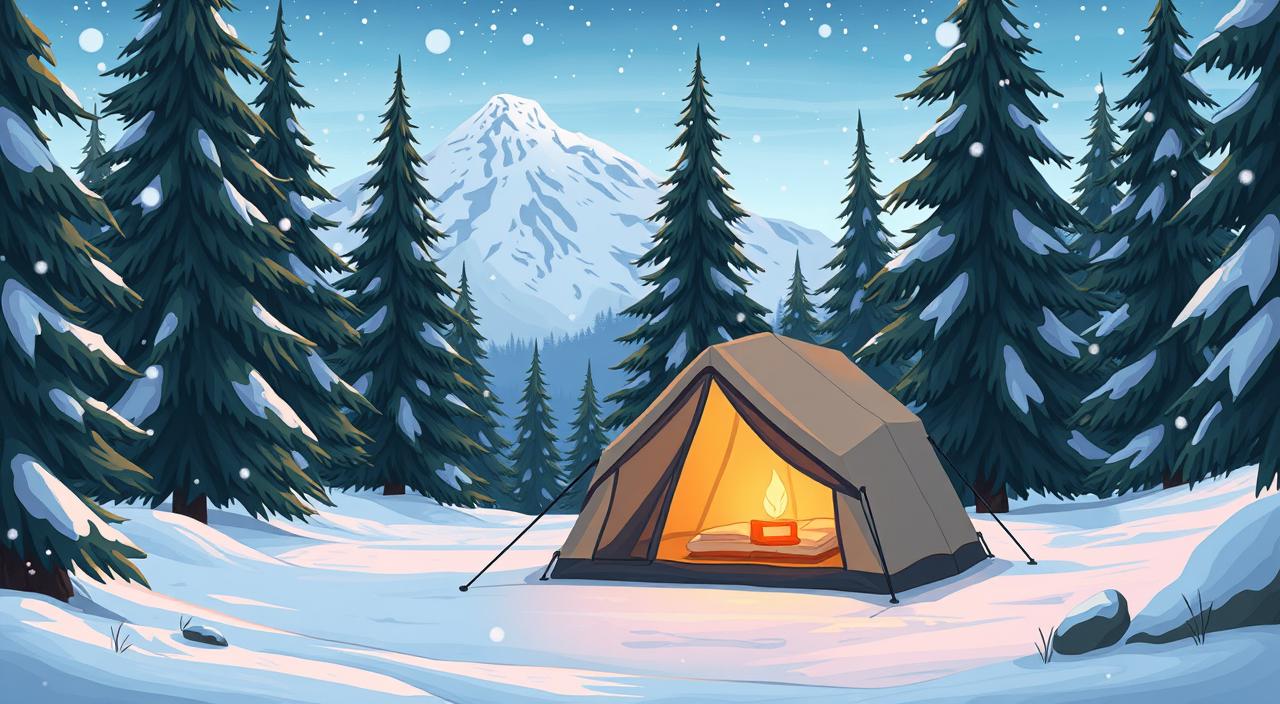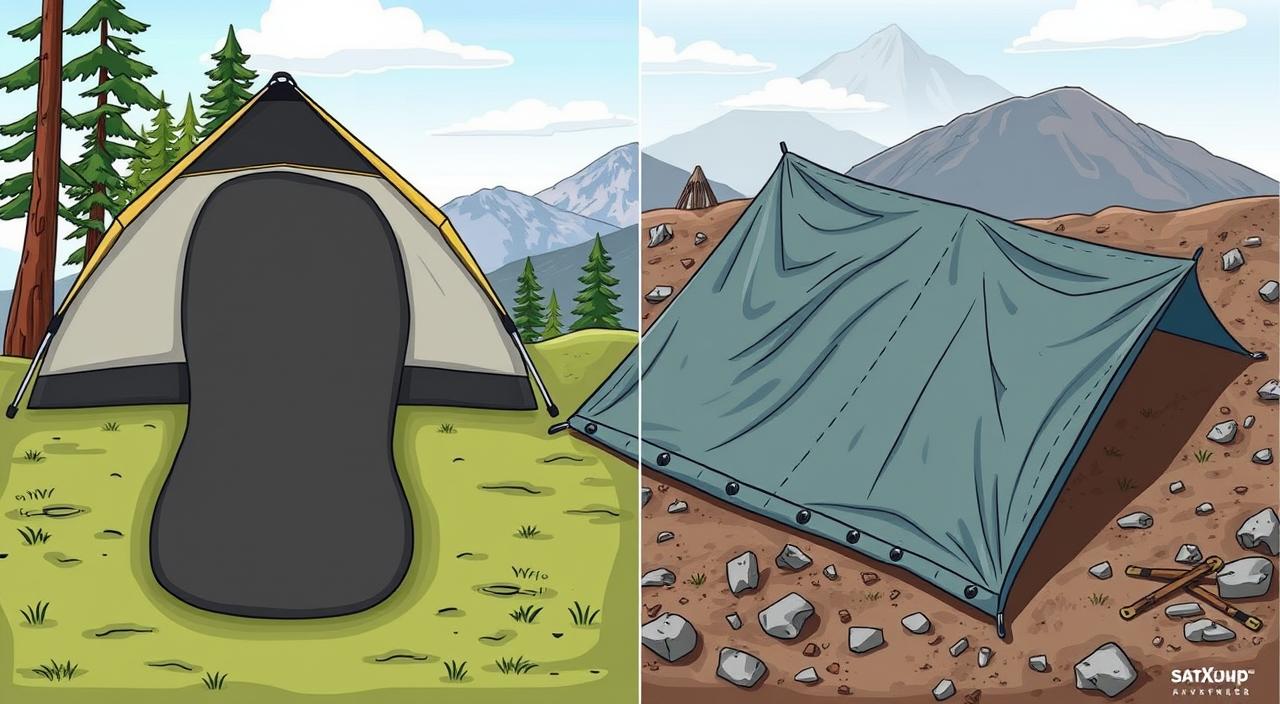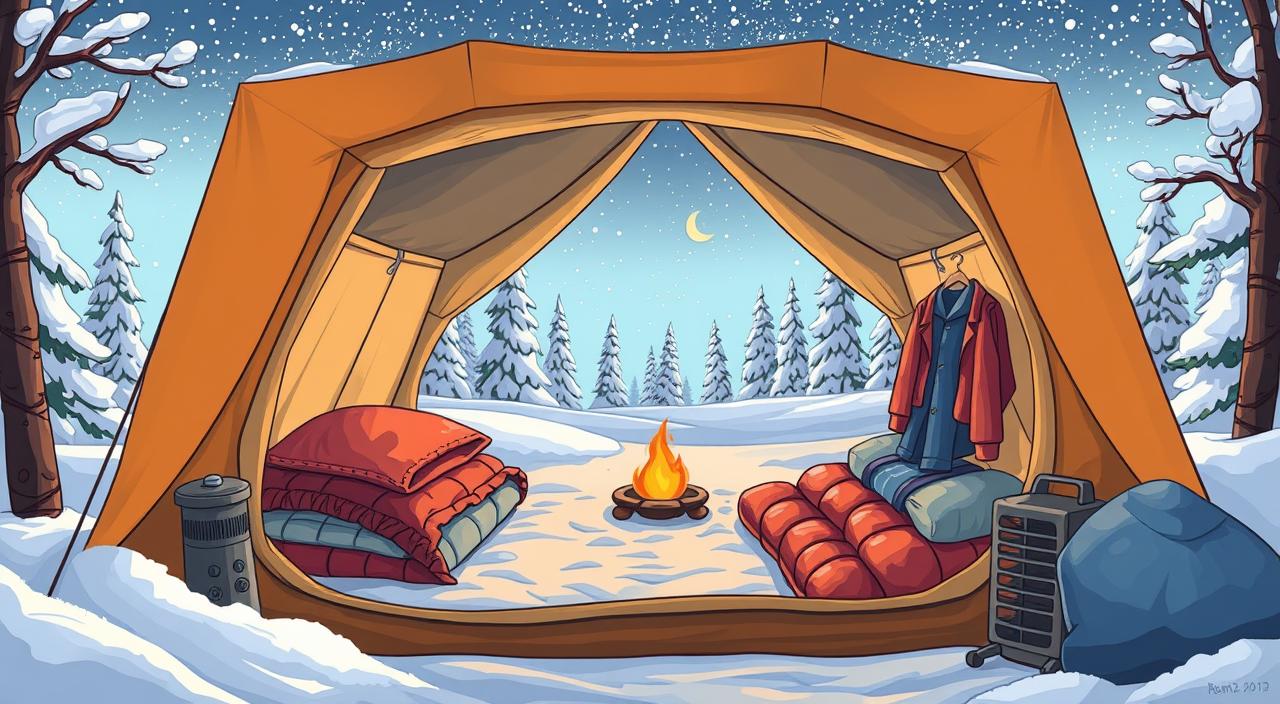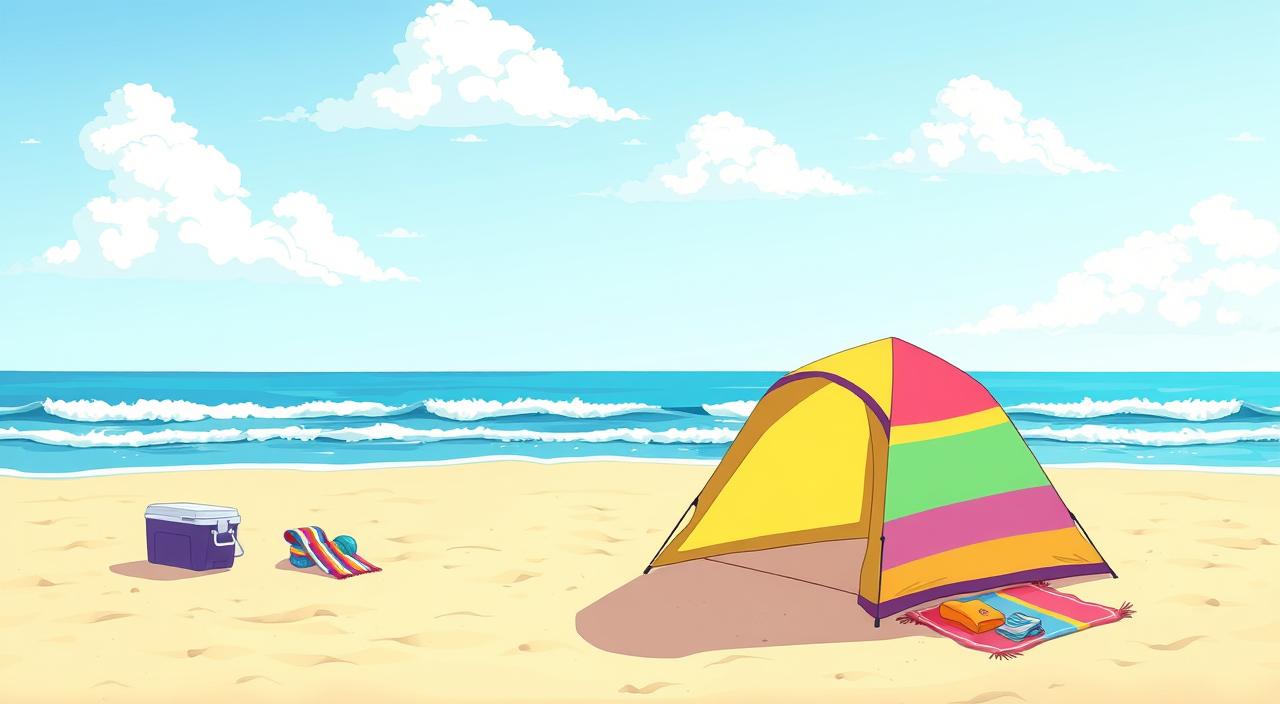
Disclaimer: This post may contain affiliate links. As an Amazon Associate, we earn from qualifying purchases.
Have you ever set up camp on the beach only to find your tent flapping wildly in the breeze or, worse, being swept away by shifting sands? Beach camping can be a beautiful way to escape, but setting up a tent in sand is tricky. It can quickly turn your outdoor adventure into a challenge.
In this article, we’ll cover how to set up a tent on the beach right. We’ll make sure your beach vacation is as relaxing as it should be.
Key Takeaways
- Understanding the challenges unique to beach camping can help you prepare better.
- Effective tent setup is crucial for a worry-free stay on the beach.
- Common mistakes can easily be avoided with the right knowledge and gear.
- Choosing the right tent stakes optimized for sand can make all the difference.
- Utilizing natural resources can be key to securing your tent effectively.
- Windproof anchoring techniques are essential to ensure your tent stays put.
Understanding the Challenges of Beach Camping
Beach camping is a wonderful way to connect with nature, but it has its challenges. One big challenge is the sandy ground, which makes it hard to set up your tent. High winds can also be a problem, making it tough to keep your tent down.
To overcome these issues, you need good sandy terrain camping tips. Make sure your tent stakes go deep into the sand to secure it well. The amount of weight you need depends on the weather and your tent’s size. Using sandbags or water barrels can help keep your tent stable.
Other things can make beach camping tricky. Sand can move, changing where your tent is. You also need to watch out for storms, as they can blow your tent away. Knowing these challenges can make your beach camping trip better.
- Unstable sandy surfaces for tent pitching
- High wind exposure affecting tent stability
- Importance of deep anchoring methods
- Weight variations for effective anchoring solutions
- Quick dismantling of tents in stormy weather
Keep these challenges in mind to have a great beach camping trip. Use sandy terrain camping tips to make your stay enjoyable by the sea.
The Importance of Proper Tent Setup
Setting up your tent right is key to a safe and fun beach camping trip. Strong winds can be a big problem at the beach, so it’s important to secure your tent well. A strong tent setup protects you from the dangers of flapping tent fabric at night.
For beach camping, use secure tent anchors made for sand. Sand needs different anchors than rocky or hard ground. Using sand anchors means burying stakes that grip the sand well. Sand/snow stakes and deadman anchors are great for keeping your tent stable in windy conditions.
Spending time on setting up your tent makes your camping trip better. You want to relax and enjoy the surroundings, not worry about your tent. Always check the area and pick the best anchoring methods for beach camping.
Common Mistakes When Staking a Tent at the Beach
Beach camping can be fun, but many make mistakes that affect their tent’s stability. Not using stakes made for sand is a big mistake. Standard metal pegs work well in soil but not in loose sand, leading to trouble.
It’s key to pick tent stakes that grip well in sand for a secure hold.
Another mistake is not securing guy lines properly. This can lead to big problems, especially when it’s windy. Studies show that winds of about 38 miles per hour mean it’s time to take down your tent. Without good anchoring, your tent could turn into a sail, making your beach trip dangerous.
Be careful with how you stake down your tent. DIY sand stakes might save money but need to be set up right to work. Burying tent legs or using sand anchors helps keep your tent steady. Big tents need heavier weights to stay secure.
Don’t forget about the type of knots you use for tie-downs. The taut-line hitch knot is great because it keeps your tent tight and lets you adjust it as needed. Always watch the weather, tighten your tent fabric, and be ready to take it down if needed to stay safe.
In short, avoiding these mistakes makes beach camping safer and more fun. Pay attention to what sandy areas need for a great camping trip.
Essential Gear for Beach Camping
Getting ready for beach camping means having the right beach camping essentials. The right camping gear makes your beach time better. You’ll need sand anchors, strong tent stakes, light tents, and a good hammer for easy setup.
Popular tent anchors include Blizzard Stakes, Eddyline Sand Stakes, and MSR Toughstake. Each has its own benefits, letting you choose what suits you best. For example, military surplus stakes are great for their light weight and strength, perfect for sandy areas.
Think about the material of your stakes. Aluminum stakes are strong yet light, while steel stakes are heavier but more durable. Fabric anchors like MSR Snow and Sand Fabric Tent Anchors also work well against wind.
Here’s a table to help you pick the right gear:
| Stake Type | Material | Weight | Length | Best For |
|---|---|---|---|---|
| Blizzard Stakes | Aluminum | Lightweight | 12 inches | Sand and rock |
| Eddyline Sand Stakes | Steel | Heavy | 10 inches | Sandy terrains |
| MSR Toughstake | Aluminum | Lightweight | 12 inches | Coastal use |
| Wooden Stakes | Wood | Cost-effective | 18 inches | General use |
| Power Pegs | Plastic | Lightweight | 6/9/12 inches | Sandbar camping |
Using special gear like spiral stakes or making your own anchor can give you extra security. With the right beach camping essentials and camping gear, you’re ready for beach camping challenges.
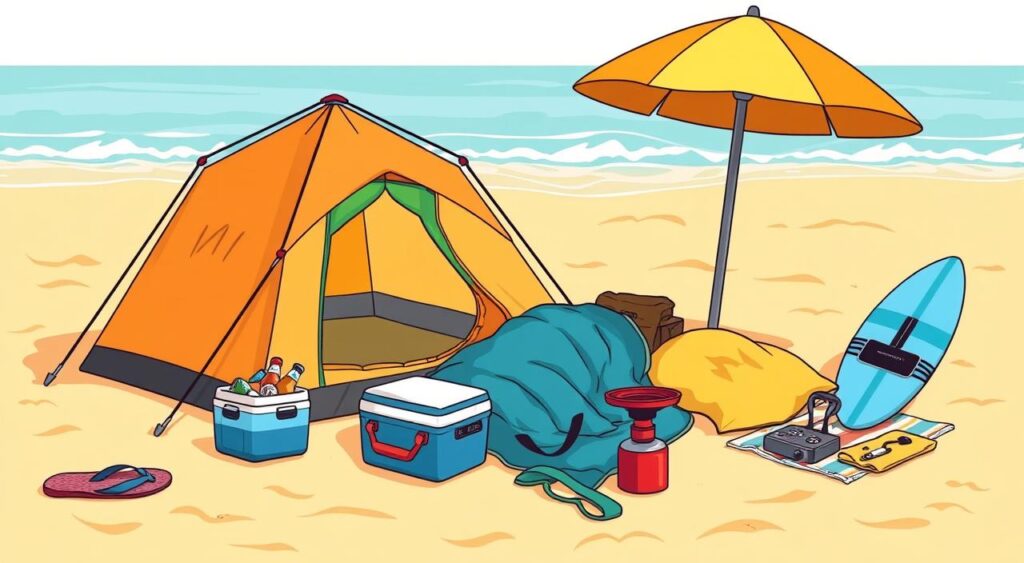
Choosing the Right Tent Stakes for Sand
When you’re camping at the beach, picking the right tent stakes is key for keeping your shelter secure in the sand. The way your tent stays anchored affects your comfort and safety. Knowing about the different types of stakes can help you pick the best ones.
Types of Tent Stakes for Sandy Terrain
Here are some options for tent stakes in sand:
- Wooden Stakes: These are often the best choice for sand, costing about as much as a single aluminum stake made for sand.
- Special Sand Stakes: Great for saving space, but they can be more expensive.
- Rocks Wrapped in Guy Lines: A handy alternative that doesn’t need traditional stakes in sandy places.
- Long Rebar Rods: They work well but might come out in strong winds, especially with a special hook.
- Aluminum U-Channel Snow Stakes: These are light, easy to take out, and have fins for extra stability.
Durability and Versatility Considerations
Think about how durable and versatile the stakes are for beach camping:
- Wooden stakes are strong and affordable, great for sand.
- Aluminum stakes, like the U-channel type, are light and have special benefits for sand.
- Using old tent poles, cut to 1 to 1.5 feet, is a green way to make good sand stakes.
- Heavy-duty plastic bags filled with sand work well and can handle winds up to 40 knots.
- For windy areas, stakes with bigger surfaces offer better stability and performance.
| Type of Stake | Effectiveness | Cost | Weight |
|---|---|---|---|
| Wooden Stakes | High | Low | Medium |
| Special Sand Stakes | Medium | High | Low |
| Rocks & Guy Lines | Variable | Free | N/A |
| Rebar Rods | Medium | Medium | Heavy |
| Aluminum U-Channel Snow Stakes | High | Medium | Light |
Looking at these options can help you pick the right tent stakes for a safe and fun beach camping trip.
Strategies for Staking a Tent in Sand
Setting up your tent on the beach can be tricky, especially with the loose soil. You’ll need some creativity and knowledge of your surroundings. Using things like driftwood and rocks can help keep your tent stable and secure.
Utilizing Natural Resources as Tent Anchors
Surrounding materials can make great anchors for your tent. Here are some ideas:
- Driftwood: Look for sturdy pieces to use as weights.
- Rocks: Use large stones nearby for extra stability.
- Sand walls: Build sand barriers around the base to keep the tent down.
Before choosing anchors, think about the size and type of your tent. Non-freestanding tents need stakes, while some freestanding tents might stay put on their own, depending on the conditions.
Beach Tent Setup Techniques
Getting your tent up early is key for a secure setup. Here are some tips:
- Use MSR Groundhog Stakes for the best grip in sand.
- Try 36″ long guylines like the 1.5 mm MLD Pro Guyline for extra tension.
- Angle your stakes at 45º for better grip in loose soil.
- Bury tent legs one foot deep for extra support.
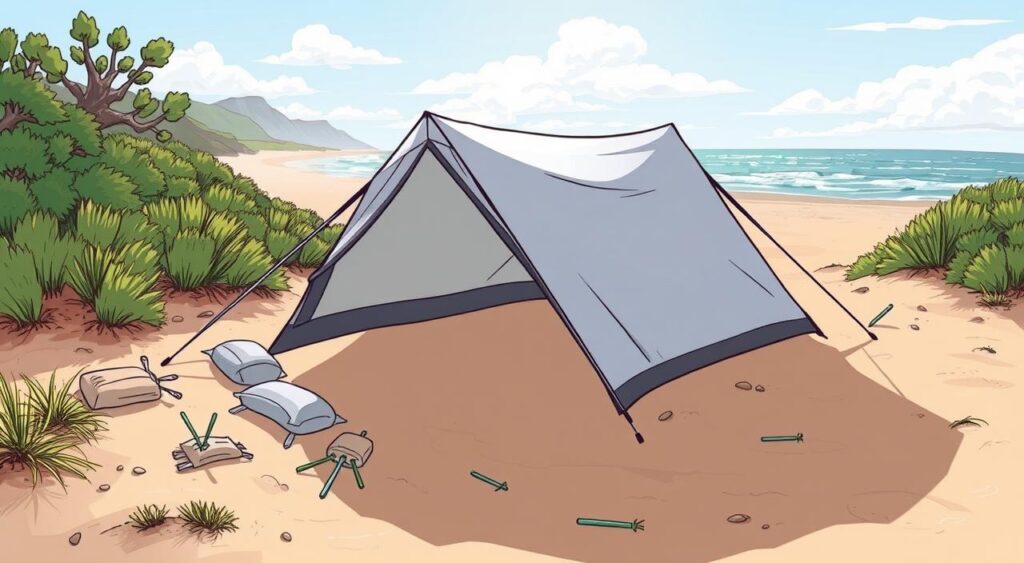
Choosing campsites near rocks makes anchoring easier. High winds can make your tent unstable. If winds hit 38 miles per hour, it might be best to use a different tent.
Windproof Tent Anchoring Techniques
High winds can be a big problem when beach camping. Using the right windproof tent anchoring techniques helps keep your tent safe. This way, you can relax and enjoy your time outside without worrying about your tent flying away. Here are some effective methods to try:
- Use sandbags: Sandbags can be heavy, weighing about 35 lbs each when full. Spread them out under your tent to make it more stable.
- Water barrels: For extra security, try using water barrels from TentCraft. They can add a lot of weight when full, keeping your tent down.
- Concrete blocks: Concrete cinder blocks are simple but effective. Each block weighs 28 lbs, making them a good choice for securing your tent.
- Cast-iron footplates: TentCraft’s 50 lbs cast-iron footplates are great for heavy-duty tents. They help keep your tent firmly in place.
Always check the weather forecast before setting up your tent. If winds are going to be over 30 MPH, think about finding a safer spot. Here are more ways to keep your tent secure:
- Use 5-gallon buckets filled with sand, gravel, or concrete and tie them to your tent with bungee cords. This keeps your tent on the ground.
- Make your own weights by filling PVC pipes with concrete and attaching them to the tent. This adds extra stability against the wind.
- Choose tough stakes and guy lines to strengthen your tent. Spread the stress out evenly to make it more resistant to wind.
- For different landscapes, consider using cloth snow anchors or sand anchors. These tools are made for specific environmental challenges.
By using these tips, you can make sure your tent stays secure in windy conditions. Enjoy your beach trip knowing your tent is ready for whatever the wind brings!
Additional Tips for a Successful Beach Camping Experience
Planning a beach camping trip? A few extra tips can make a big difference. Paying attention to details during sandy campsite preparation ensures comfort and security. By choosing the right spot and preparing your gear, you can enjoy a peaceful getaway.
Sandy Campsite Preparation
Finding the perfect spot for your tent is key to your comfort. Look for a flat area with good drainage to avoid water pooling. Stay away from sand dunes, as they are important for local wildlife.
Use longer, strong tent stakes to keep your tent down. They go deeper into the sand. If you’re worried about wind, set up near bushes or trees for extra protection.
Keeping Your Tent Secure During High Winds
Weather at the beach can change fast. Always check the forecast before you go. Use a tent with a rainfly and sand stakes made for windy conditions.
To keep your tent stable, attach guy lines to it. Make sure they’re tied to something solid or weighted down with sandbags. Check your tent often, especially in windy weather. These steps make keeping your tent secure easier.
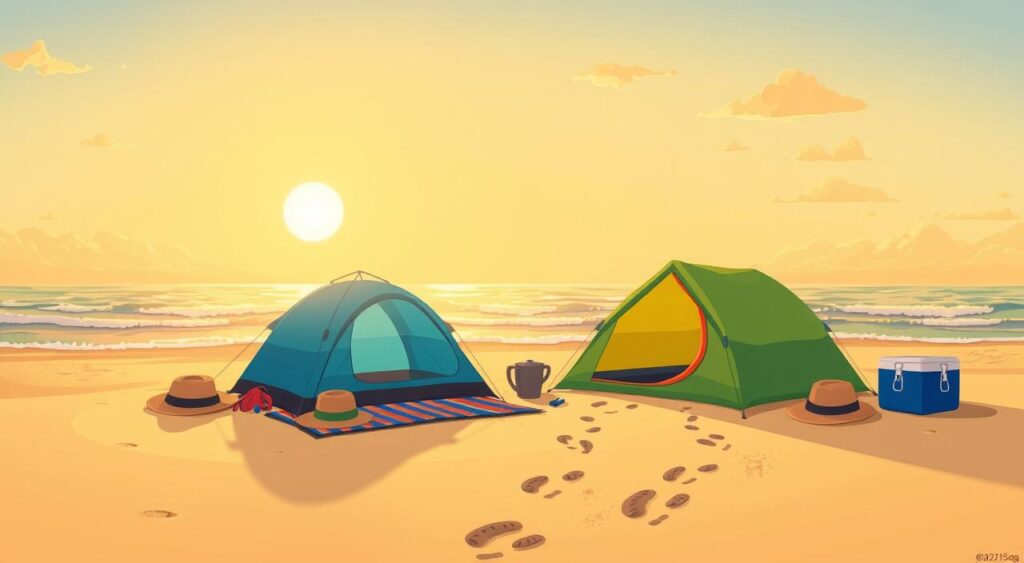
Taking Care of Your Tent Equipment
Looking after your tent is key to making it last longer. New tents are better now, so taking good care of them is more crucial. Before you go camping, check your tent for any damage or wear that could cause problems on your trip.
Even if your tent is supposed to be waterproof, you should waterproof it again. Use Nikwax Tech Wash to keep the DWR finish working well. This helps you enjoy camping without worrying about leaks.
Carry extra parts like zippers, needles, and duct tape for any small repairs while camping. Setting up your tent at home can help avoid damage when you’re out. Use the right stakes for different ground types, especially in bad weather.
Too much sunlight can harm your tent fabric. Try to set up in the shade to protect your gear from UV rays. Using a tent footprint or tarp helps keep the floor safe and makes your tent cleaner and more comfortable.
To stop condensation, make sure your tent has good airflow. Clean and dry your tent well after each use to stop mold. Always follow the maker’s cleaning advice, which usually means using warm water to avoid damaging the fabric.
Tents are a big investment, but with the right care, they last a long time. Choose campsites with smooth dirt to be easier on your tent. Remember, animals might try to get into your tent for food, so keep your food safe. Zippers wear out fast, so make sure to look after them well.
Here are some tips for taking care of your tent:
- Regularly inspect for damages.
- Waterproof as needed with quality products.
- Use appropriate stakes for various terrains.
- Protect from UV rays when possible.
- Utilize ground covers to prevent damage.
- Ensure ventilation to avoid condensation.
- Thoroughly clean and dry after each use.
- Bring repair supplies on every trip.
Following these tips will help you take better care of your tent. This will not only make it last longer but also improve your camping trips.
Conclusion
Getting the most out of beach camping is more than picking the best spot. It’s about setting up your tent right and knowing how to keep it secure. By learning how to stake your tent in sand, you make sure your trip is both safe and fun. Using gear like wind-resistant tents and special stakes is key to a successful beach camping trip.
It’s important to adjust your camping ways based on the environment. Using DIY sand stakes and other anchoring methods like burying tent legs or using weights helps keep your tent stable. Always watch out for the weather and follow the advice in this article. Proper spacing and stake placement prevent accidents and help you relax at the beach.
For more tips on tent anchoring, check out comprehensive techniques and gear recommendations for different landscapes. Following these tips lets you and your friends enjoy the beach safely and make your next camping trip unforgettable.




